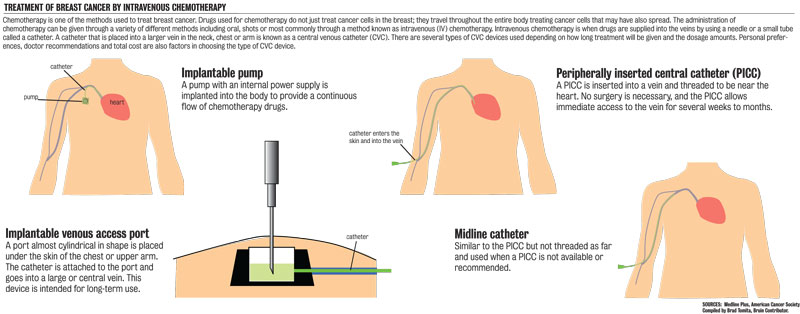As the No. 1 cancer diagnosis among American women, breast cancer has created a vast web of affected mothers, daughters, sisters and grandmothers.
“Most people who are over the age of 35 know someone (who), or are related to someone (who), or have themselves (been) diagnosed with cancer,” said Dr. Sara Hurvitz, leader of the breast cancer clinical trials program at UCLA.
Like any cancer, breast cancer is associated with the spontaneous growth of excess cells in a localized area of the body, particularly in the breast tissue.
With the exception of the 5 percent to 10 percent of cases related to hereditary factors, most cancer cases are largely due to chance, said Joyce Seldon, a genetics counselor at UCLA’s Jonsson Comprehensive Cancer Center. However, general lifestyle choices begun at a young age could curb the likelihood of breast cancer’s onset.
Low-fat diets, regular exercise, decreased alcohol consumption and sufficient Vitamin D intake appear to be helpful in preventing breast cancer, Hurvitz said.
Knowing an individual’s family history is also essential for identifying cancer susceptibility.
According to Dr. Nova Foster, assistant clinical professor of surgery at the UCLA Cancer Center, there are three major considerations for seeking a genetic counselor: age, heritage and family history. Any woman under the age of 40 with a breast cancer diagnosis, especially a woman of Ashkenazi Jewish heritage and a family history of breast and ovarian cancer diagnoses, should seek a genetics counselor to determine the likelihood of cancer incidence.
“You can’t control genes, but you can control your environment,” said Dr. Saeed Sadeghi, a clinical faculty member at the cancer center.
Breast cancer’s high incidence rates and potential for fatality has created a strong movement of support in the medical world and mainstream media, topping the list of lobbyists and researchers for funding in continued studies and scientific breakthroughs.
“Because it is the most common cancer (among women), there are a lot of efforts going into research, prevention and treatment,” Sadeghi said. “I think it’s a combination of factors ““ better research for diagnosis as well as treatment.”
But an increase in awareness does not indicate a steady yearly growth in the number of diagnoses and deaths.
“As a whole, breast cancer incidence in the U.S. is fairly stable year to year,” Saghedi said. “There was an actual slight decrease in (cases recently).”
Decreased mortality rates from breast cancer may be attributed to multiple factors like better screening technologies, including mammograms, breast imaging and clinical breast exams, as well as a drop-in use among women of post-hormonal therapy after menopause, Hurvitz said.
While the average age of women diagnosed with breast cancer is 61, the few hereditary cases tend to be very early onset, Seldon said.
“An early age ““ say, 41 ““ that could be a red flag that we might be dealing with a hereditary case,” Seldon said.
Among ongoing research oriented toward further understanding of the genetic components of these various forms of breast cancer, two breast cancer susceptibility genes are most common: Breast Cancer 1 and Breast Cancer 2. While both are hereditary, BRCA2 seems to be the more common cancer, Seldon said.
Women who have a genetic disposition to carry these genes, as analyzed by a blood test, have a 60 (percent) to 85 percent chance of contracting cancer and are therefore at risk for cancer incidence at a significantly younger age, Seldon said.
While surgery is the favored treatment for most cancer types, hereditary or not, the stage of cancer determines the preferred surgical treatment. An earlier stage of cancer exists in a more localized area, allowing for only partial removal of the breast tissue, under a procedure called a lumpectomy, Sadeghi said.
Because advanced screenings have better been able to detect breast cancer in its earlier stages, a lumpectomy is the most common treatment procedure for regular cases of women at the post-menopausal age, Foster said.
A lumpectomy is followed by radiation therapy in order to sterilize the cancer and ensure that it does not recur in either breast.
“Generally speaking, with larger or more aggressive tumors, when you’re done with surgery, the first thing you do is chemotherapy,” Foster said. “Usually that’s in the setting of a large, locally advanced tumor.”
When the cancer spreads during its later stages, a mastectomy removes the entire affected breast tissue. Performed to prevent any possibility of cancer reoccurrence, a mastectomy does not need to be accompanied by radiation therapy.
But in special cases, according to Seldon, a woman may decide to remove one or both breasts before a diagnosis. If the individual with a family history of breast or ovarian cancer is found to be a BRCA1 or BRCA2 carrier, her chance of contracting breast cancer is 60 percent to 85 percent more likely than a non-carrier. Therefore, the surgery, called a bilateral prophylactic mastectomy, can be performed as a preventative measure.
It is generally limited to women who have recently been diagnosed with a hereditary form of breast cancer, Seldon said.
“(Bilateral prophylactic surgery) is an option, but it’s a very personal decision. It depends a lot of times on their experience with breast cancer,” Seldon said. “Hereditary cases, like a young woman who lost her mother … is different from someone else who was diagnosed at an earlier age and (survived).”
